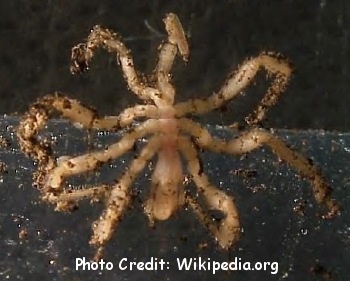
By Bob Goemans


These small spider-like creatures belong in the very large Phylum Arthropoda, which contains both the terrestrial and marine animals known as insects or crustaceans. Since they are more crab-like, they are being shown in this grouping.
They are found throughout the seas and oceans, including the Artic and Antarctic oceans. There are about 1000 known species ranging in size from a few millimeters to about 20 inches (50 cm) or more. Most are found in shallow marine and estuarine waters, yet some come from depths of over 20,000 feet. They live under rocks, on dock pilings, around hydroids and bryozoans, and feed upon hydroids, sponges, soft corals, anemones, small worms, and algae with a hose-shaped mouth/trunk (proboscis) that sucks their prey's juices.
Their body generally appears to be nothing more then a grouping of legs attached to a tiny central body, which has two parts, the head and a trunk. The head contains various organs and appendages for sensing and feeding upon prey. The trunk is usually divided into four segments, each having a pair of long legs attached giving this carnivorous creature a spider-like appearance. Even though most have eight legs, some species have as many as five or six pair of legs. It also usually has four eyes mounted on a raised turret-like structure called a 'tubercle.' As for feeding, its proboscis, which penetrates the animals covering, contains three small teeth that can alter/prepare the food before it enters this trunk-like tube. They have no respiratory system and gas exchange is accomplished through the body covering (diffusion). Their digestive tract has branches extending into their legs and their organs extend throughout many appendages because its body is too small to accommodate all of them.
Not commonly seen in the wild, nor collected for the trade, however, occasionally some very tiny ones come in on various coral animals or live rock as a hitchhiker. Not what I would came a desirable creature in marine aquariums! Pictured here is a photo by Bill Rudman (http://www.seaslugforum.net/pycnogon.htm) of the slug eating sea spider Anoplodactylus evansi, and two other specimens (divegallery.com and wikipedia.org), along with two photos courtesy of Tristan Lougher for your viewing. Visit these sites for more information.